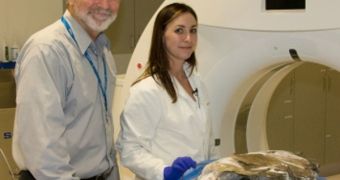Researchers with the Translational Research Imaging Center at the University of California in Los Angeles (UCLA) recently conducted a computerized tomography (CT) scan on a massive oarfish specimen discovered beached in California. This is the first time the inner structure of the creature is studied with such advanced medical imaging techniques.
The giant fish was discovered in Oceanside last month, and is the second oarfish to die on land in the last 30 days. This particular specimen was a rare, 4.3-meter (14-foot) long monster fish, weighing in at around 114 kilograms (250 pounds).
Researchers with Cal State University, Fullerton (CSUF), led by ichthyologist Misty Paig-Tran, promptly asked colleagues from TRIC, and UCLA chairman of radiology Dr. Dieter Enzmann, for permission to use the university's CT imager to look at the fish. The creature was filleted in nine pieces for ease of handling.
Scientists from CSUF and UCLA came together to study this mysterious deep-sea species on November 21. Many researchers believe that creatures such as this spawned many of the sea legends still traveling the world today. The oarfish was first captured and characterized in 1772.
It is very unusual for deep-sea creatures to beach themselves on land. The oarfish, for example, lives at depths of around 1,000 meters (3,300 feet) under the surface. Despite the harsh conditions of its habitat, it can grow to be up to 10 meters (30 feet) long, and weigh around 272 kilograms (600 pounds).
Paig-Tran says that the red-finned specimen which recently underwent CT scanning was a female, and adds that its ovaries contained millions of fresh eggs. Her group will now begin counting and analyzing these eggs, since such an effort has never been focused on the oarfish before.
The CT scans were not performed just for laughs. Ichthyologists say that the fish's dorsal fin is extremely interesting as a swimming implement. “The oarfish hangs motionless in the water for much of the day, except for its continuously beating dorsal fin, which is bidirectional,” Paig-Tran explains.
The scans were conducted to obtain data that could potentially “explain why the fish moves its fin this way and how its soft skeleton contributes to its swimming performance,” she goes on to say.
After researchers finish creating a 3D model of the rare oarfish, the CSUF team will proceed to dissect the creature, and analyze its bones for additional clues as to what underlies is extraordinary swimming abilities.

 14 DAY TRIAL //
14 DAY TRIAL //